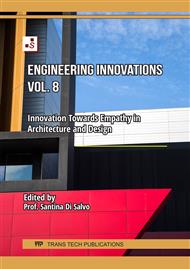[1]
Information on https://www.domusweb.it/it/progettisti/alvaro-siza.html.
Google Scholar
[2]
G. Vasari, Vite de più eccellenti Architetti, Pittori, et Scultori Italiani, da Cimabue insino a' tempi nostri (etc.), Firenze, 1550.
DOI: 10.1007/978-3-476-05728-0_21414-1
Google Scholar
[3]
P. Adorno, L'arte italiana, Casa editrice D'Anna, Firenze, 1996, vol. 2, pp.51-62.
Google Scholar
[4]
W. Lotz, Architettura in Italia 1500 - 1600, Rizzoli, Milano, 1995, pp.105-106.
Google Scholar
[5]
R. Wittkower, Arte e architettura in Italia. 1600-1750, Einaudi, Torino, 1972, pp.314-320.
Google Scholar
[6]
S. Calcagna, Elementi di natura vulcanica nel paesaggio urbano, in: A.M. Atripalda, M. E. Costa (Eds), Catania. Architettura, città, paesaggio, Gruppo Mancosu Editore, Roma, 2008, pp.262-273.
Google Scholar
[7]
A. Mazzè, Calcestruzzo. Pozzolana. Lava, Pitti edizioni, Palermo, 2002, pp.53-67, 101122.
Google Scholar
[8]
Information on etnanatura.it/paginasentiero.php?nome=Ponte_Saraceno.
Google Scholar
[9]
AA.VV., L'arte siculo-normanna. La cultura islamica nella Sicilia Medievale, Kalos, Palermo, 2007, pp.276-281.
Google Scholar
[10]
J. May, Architettura senza architetti, Rizzoli, Milano, 2010, pp.22-23, 70-71.
Google Scholar
[11]
M. L. Germanà, Earth in ancient Sicilia architecture, in: S. Mecca (EDS), Earth/Lands. Earthen Architecture in Southern Italy, Edizioni Ets, Pisa, 2011, pp.167-186.
Google Scholar
[12]
L. Fontana, Costruire in terra cruda, Vitali e Ghianda, Genova, 2007.
Google Scholar
[13]
information on https://rivista.inarcassa.it/-/terra-cruda-un-antica-contemporaneit%C3%A0.
Google Scholar
[14]
M. Achenza, U. Sanna (Eds), Il manuale tematico della terra cruda, Dei Tipografia del Genio Civile, Cagliari, 2000-2006.
Google Scholar
[15]
E. Baglioni, Costruzioni in terra cruda: dall'antichità all'architettura sostenibile, in https://www.ingenio-web.it/35226-costruzioni-in-terra-cruda-dallantichita-allarchitettura-sostenibilefull pdf in https://www.researchgate.net/publication/363104195.
Google Scholar
[16]
Information on https://www.theplan.it/whats_on/tradition-and-innovation-la-tradizione-come-asset-creativo-per-innovare-l-architettura.
Google Scholar
[17]
Information on https://www.theplan.it/architettura/un-padiglione-in-argilla-firmato-alvaro-siza.
Google Scholar
[18]
Information in https://www.theplan.it/architettura/a-passo-di-monte-croce-non-uno-chalet-n%C3%A9-un-rifugio-un-punto-di-riferimento-tra-le-dolomiti.
Google Scholar
[19]
Information on https://www.theplan.it/architettura/voyage-torba-un-hotel-diffuso-e-incontaminato-sul-mare-egeo.
Google Scholar
[20]
A. Giuffrè (Eds), Sicurezza e conservazione dei centri storici. Il caso Ortigia, Editori Laterza, Roma, 1993.
Google Scholar
[21]
S. Settis, Il paesaggio come bene comune, La scuola di Pitagora editrice, Napoli 2013, p.18.
Google Scholar
[22]
G. Biscontin, G. Driussi (Eds), Quale sostenibilità per il restauro? Atti del convegno di studi. Bressanone 1-4 luglio 2014, Edizioni Arcadia Ricerche, Venezia, 2014.
Google Scholar


